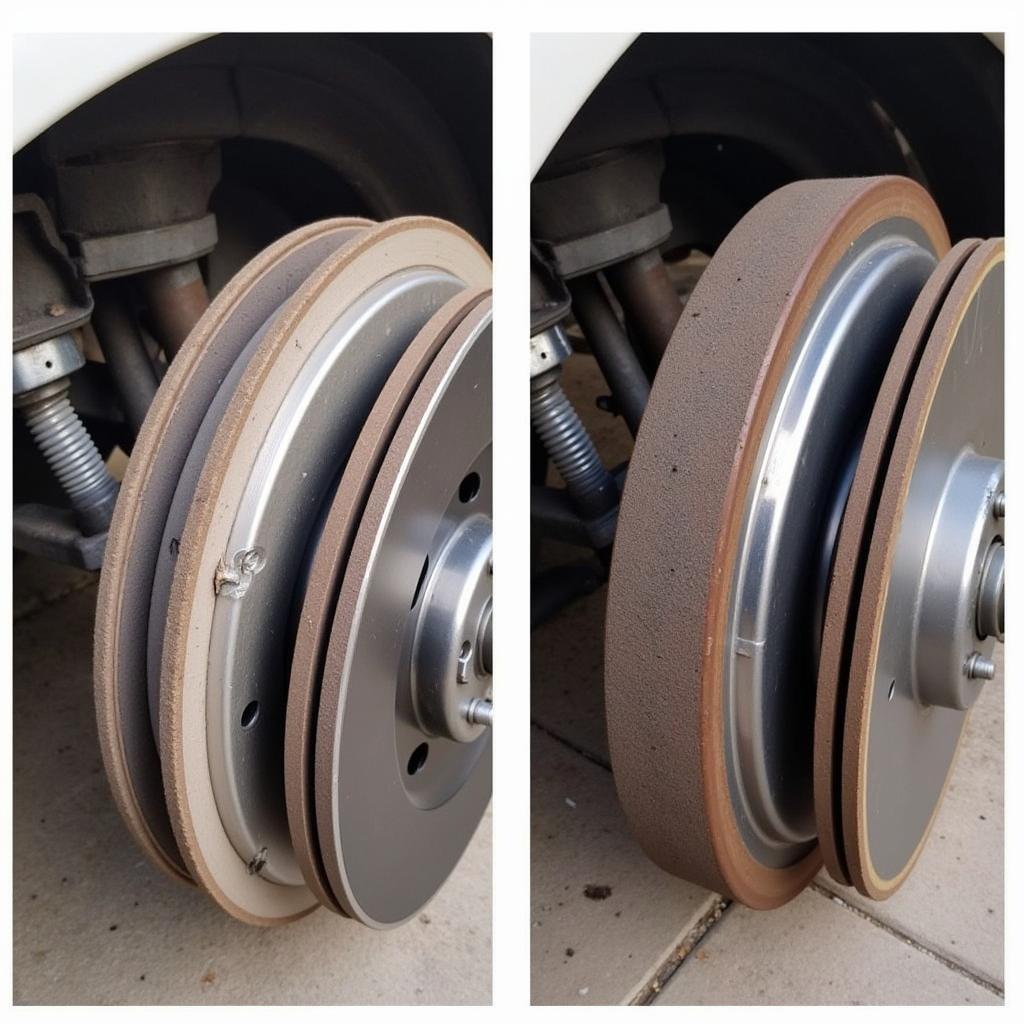If you’re driving in California and your “brake shoes california warning” light pops up, it’s crucial to address it immediately. This warning light typically indicates that your brake shoes are wearing thin and require replacement. Ignoring this warning can compromise your braking system and put you and others at risk. This article delves into the importance of brake shoes, why they trigger a warning in California specifically, and what steps you should take to ensure your safety on the road.
Understanding the Brake Shoe Warning Light
Your car’s brake system is designed with various components working together to ensure safe and efficient stopping. Brake shoes, often located in the rear wheels, play a crucial role in this process. As you press the brake pedal, hydraulic pressure activates the brake shoes, pushing them outward to create friction against the brake drum. This friction slows down the wheel’s rotation, ultimately bringing your vehicle to a stop.
The “brake shoes california warning” light is triggered by a sensor that monitors the thickness of your brake shoes. California, known for its strict safety regulations, requires this sensor in vehicles to ensure drivers are alerted promptly about worn-out brake shoes. This proactive approach helps prevent accidents caused by brake failure.
Why are Brake Shoes Important?
Brake shoes are the unsung heroes of your braking system. They endure tremendous amounts of heat and friction every time you brake. Over time, this wear and tear causes the friction material on the brake shoes to thin down. Once this material wears down beyond a certain point, it reduces the effectiveness of your braking system, leading to longer stopping distances and potential safety hazards.
 Worn Brake Shoes vs. New Brake Shoes
Worn Brake Shoes vs. New Brake Shoes
What to Do When the “Brake Shoes California Warning” Light Turns On
If the “brake shoes california warning” light illuminates on your dashboard, don’t panic. Instead, follow these steps:
- Reduce Your Speed and Drive Cautiously: The first and most crucial step is to reduce your speed and drive with increased caution. Remember, your braking distance might be longer than usual.
- Avoid Heavy Braking: Minimize the need for sudden or hard braking as much as possible. This puts excessive stress on your already compromised brake shoes.
- Find a Safe Place to Pull Over: As soon as possible, find a safe location to pull over and assess the situation.
- Inspect Your Brake Shoes (If Possible): While not everyone is comfortable with car maintenance, if you have the knowledge and tools, you can visually inspect your brake shoes. Look for significant wear and tear.
- Seek Professional Help: Whether you could inspect your brake shoes or not, it’s essential to schedule an appointment with a qualified mechanic as soon as possible. They have the expertise and equipment to diagnose the issue accurately.
Can I Continue Driving with the Warning Light On?
While you might be tempted to continue driving with the “brake shoes california warning” light on, it’s strongly discouraged. Driving with worn-out brake shoes puts you and others on the road at risk. Your braking distance will be significantly affected, making it difficult to stop in emergencies.
“Ignoring brake warning lights is like playing Russian roulette with your safety,” says Mark Stevenson, a certified automotive technician with over 20 years of experience. “Even if your brakes seem to be working fine, that warning light is telling you something is wrong, and it needs immediate attention.”
The Importance of Regular Brake Inspections
Just like any other component in your vehicle, brake shoes require regular inspections and maintenance. Most mechanics recommend having your brakes inspected at least once a year or every 12,000 miles, whichever comes first.
 Mechanic Inspecting Brake Shoes
Mechanic Inspecting Brake Shoes
During a brake inspection, a qualified mechanic will:
- Visually inspect your brake shoes for wear and tear
- Measure the thickness of the friction material
- Check the brake drums for any signs of damage or scoring
- Inspect the hydraulic components of your braking system
Regular inspections not only help catch potential issues early on but also ensure your brake system operates at peak efficiency, providing you with optimal stopping power and peace of mind.
Conclusion
The “brake shoes california warning” light is a crucial safety feature designed to alert drivers about potentially dangerous brake wear. If this light illuminates on your dashboard, it’s vital to address the issue promptly by reducing your speed, driving cautiously, and seeking professional help from a qualified mechanic. Regular brake inspections are paramount in preventing unexpected issues and ensuring your safety on California roads. Don’t compromise when it comes to brakes – prioritize your safety and the safety of others.
